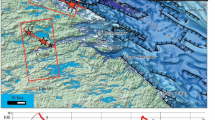Abstract
Series of geologically and seismically active ruptures with amplitudes of vertical and horizontal dislocations from some tens of centimeters up to 2.5 m was studied using the paleoseismological method within mobile folded systems of Northern Eurasia (the Mountain Altai and the north of the Kamchatka region) during the field works for the last decade. The paleoseismological materials have been used to estimate the seismic regime of the specified regions for the major Holocene. Micro- and macroseismic data of strong seismic events of these regions were also used, including the latest strong seismic shocks of 2003 and 2006. The results demonstrate rectilinear recurrence diagrams throughout the whole range of magnitudes in the two regions of Northern Eurasia explored. It means that the seismic regime at the Late Quaternary of the geological history has remained almost unchanged.











Similar content being viewed by others

References
Bune VI (1980) Map SR-78 in the USSR. In: Bune VI, Gorshkov GP (eds) Seismic zoning of the USSR. Nauka, Moscow, pp 83–97 (in Russian)
Dorbath C, Van der Woerd J, Arefiev SS, Rogozhin EA, Aptekman JY (2008) Geological and seismological field observations in the epicentral region of the 27 September 2003 Mw 7.2 Gorny Altay earthquake. Bull Seismol Soc Am 98(6):2849–2865
Gutenberg B, Richter CF (1949) Seismicity of the earth and associated phenomena. Princeton University Press, Princeton
Hatheway AW, Leighton FB (1979) Trenching as an exploratory method. In: Geology in the sitting of nuclear power plants, Vol. IV, Geologic Society of American Reviews in Engineering Geology, New York, pp 169–196
Hromovskyh VS, Solonenko VP, Semenov RM, Shilkin VM (1979) Paleo-seismology of the greater Caucasus. Nauka, Moscow
Kondorskaya NV, Shebalin NV (eds) (1977) New catalog of strong earthquakes in the USSR from ancient times until 1975 AnsScience. Russian Academy of Sciences, Moscow
McCalpin JP (ed) (2009) Paleoseismology, 2nd edn. Academic Press, Amsterdam; London
Nissen E, Emmerson B, Funning GJ, Mistrukov A, Parsons B, Robinson DP, Rogozhin E, Wright TJ (2007) Combining inSAR and seismology to study the 2003 Siberian Altai earthquakes-dextral strike-slip and anticlockwise rotations in the northern India-Eurasia collision zone. Geophys J Int 169:216–232
Pantosti D, Schwartz DP, Valensise G (1993) Paleoseismology along the 1980 surface rupture of the Irpinia fault: Implications for earthquake recurrence in the southern Apennines, Italy. J Geophys Res 98:6561–6577
Riznichenko YuV (1958) About study of the seismic mode. Izvestiya USSR Ser Geophys 11:1057–1074
Riznichenko YuV (1980) Seismic mode and seismic activity. In: Bune VI, Gorshkov GP (eds) Seismic zoning of the USSR. Nauka, Moscow, pp 47–58
Rogozhin EA (2010) Reconstruction of long-term seismic regime using paleoseismogeological data. In: Laverov NP (ed) Extreme natural phenomena and catastrophes. V. 1: evaluation and ways to reduce the negative effects of extreme weather events. IPE RAS, Moscow, pp 44–64
Rogozhin EA, Jun Shen, Rodina SN (2013) Comparison of seismotectonic peculiarities of Altai Mountains and Mongolian Altai. Seism Instrum 49(4):285–296. doi:10.3103/S0747923913040063
Rogozhin EA, Novikov PP, Rodina SN (2010) Paleoseismic ruptures and the long-term seismic regime of the Koryak uplands. Geophys Stud 11(4):35–43
Rogozhin EA, Ovsyuchenko AN, Marahanov AV (2008) Strongest earthquakes in the south of the Mountain Altai in the Holocene. Phys Solid Earth 44(6):469–486. doi:10.1134/S1069351308060037
Rogozhin EA, Ovsyuchenko AN, Marakhanov AV, Novikov SS (2009) Tectonic position and geological manifestations of the 2006 Olyutor earthquake in Koryakiya. Geotectonics (6):3–23. doi:10.1134/S0016852109060016
Solonenko VP (1973) Paleoseismogeology. Phys Solid 9:3–16
Solonenko VP, Florensov NA (eds) (1985) Earthquakes and the bases of the seismic zoning of Mongolia. Nauka, Moscow
Ulomov VI, Shumilina LS (1999) The set of maps of general seismic zoning of the Russian Federation: the SRF-97. Scale 1: 8 000 000 explanatory notes and a list of cities and towns located in earthquake-prone areas. UIPE RAS, Moscow
Wells DL, Coppersmith KJ (1994) New empirical relationships among magnitude, rupture length rupture width, rupture area, and surface displacement. Bull Seism Soc Am 84(4):974–1002
Acknowledgments
The author is grateful to Prof. P. Varga for his interest to the trenching results in the strong earthquake zones of the Mountain Altai and the Kariak upland. The work was supported by the Russian Foundation for Basic Research (Projects 13-05-91168-a, 14-05-00091a) and by the Presidium of the Russian Academy of Sciences (Program no. 4).
Author information
Authors and Affiliations
Corresponding author
Rights and permissions
About this article
Cite this article
Rogozhin, E. Long-term seismic regime reconstruction using paleoseismological data. Acta Geod Geophys 50, 63–77 (2015). https://doi.org/10.1007/s40328-014-0086-0
Received:
Accepted:
Published:
Issue Date:
DOI: https://doi.org/10.1007/s40328-014-0086-0


